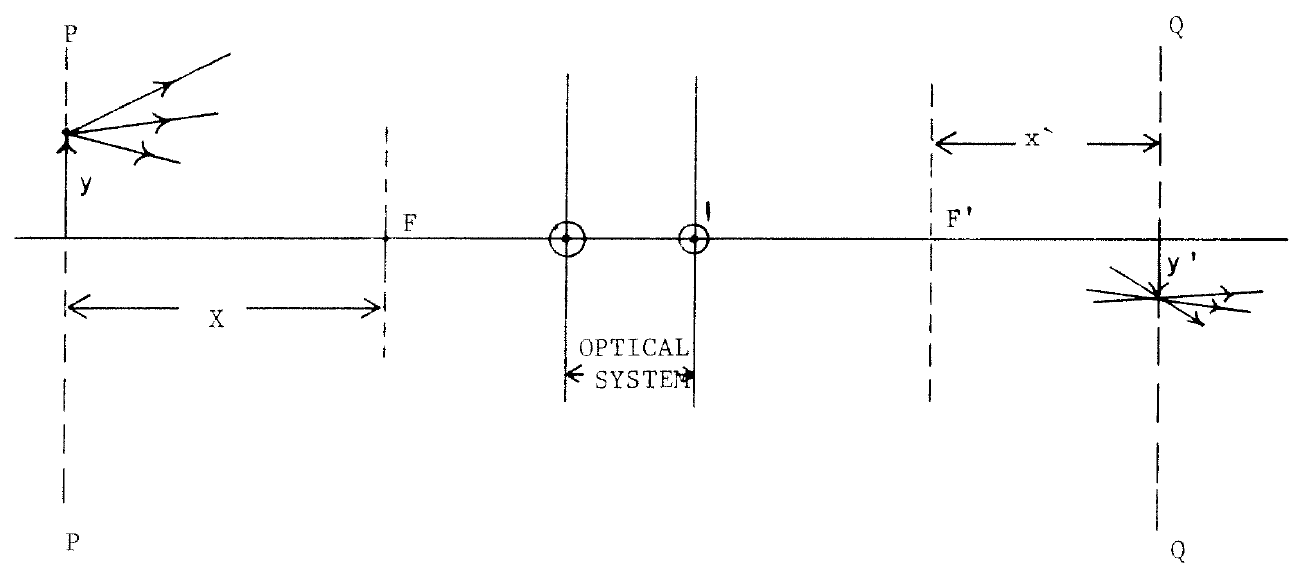承上篇,固然一個一般光學矩陣
![]()
之主平面成像公式
![]()
已經足夠。然而在討論 ![]() 、
、 ![]() 之正負號時並不方便。何不以前焦點面
之正負號時並不方便。何不以前焦點面 ![]() 、後焦點面
、後焦點面 ![]() 將之改寫為焦、焦面矩陣形制呢︰
將之改寫為焦、焦面矩陣形制呢︰

簡單矩陣計算
後焦距空間 * 系統矩陣 * 前焦距空間
可以證明︰
![]() 。
。
若此光學系統處於同一介質中,則
![]() 。
。
因此牛頓成像法則依舊成立︰
![]()
此處 ![]() 在前焦距
在前焦距 ![]() 之前為正,在前焦距之後為負;
之前為正,在前焦距之後為負; ![]() 在後焦距
在後焦距 ![]() 之後為正,後焦距之前為負。故而方便以焦距
之後為正,後焦距之前為負。故而方便以焦距 ![]() 為尺,探討物、像之位置也。
為尺,探討物、像之位置也。
當真無有疑義焉?若以主平面為參考系,果然
![]()
![]()
的 耶??
![]()
![]()
![]()
![]()
故知不同參考系之選擇實為簡化論述乎!!
所以用 ![]() ,得
,得 ![]() ;以及
;以及 ![]() ,得
,得 ![]() 。誠有好處的也。
。誠有好處的也。
那麼《光的世界︰矩陣光學六己》文本之
![]() 。
。
所說何事的呢??!!這是講該光學系統不滿足
![]() 的哩!!??
的哩!!??
今天是
教師節
教師節是一個感謝老師一年來教導的節日,旨在肯定教師為教育事業所做的貢獻與努力。不同國家訂定「教師節」的時間有所不同。1994年聯合國教科文組織訂每年10月5日為世界教師日。1985年9月10日,是中華人民共和國第一個教師節,中華民國則以9月28日訂為教師節。
不知到底誰該放、不放假???想起古代
子曰:自行束脩以上,吾未嘗無誨焉。
!!!
或許現象總需要親自體驗,才容易同理同感吧︰
隱約聽著 Mrphs 繼續說道︰這湖心小築裡有六個『學園』 Campus 是為小學堂暑修寒訓之『學習營』而預備。湖心平台上的是『天文 ‧氣象營』,其餘往下數,『科技營』在二十五層,『人文營』位於五十層,『海洋營』居七十五層,『地理營』佔第一百層。其實還有一個『生命館』屬於全體谷 民,就設立於入口大廳。這個大廳的格局象個『 ![]() 』田字,分有東南西北四館。其中東西北三館是『水』的三相 ── 水‧溼‧冰 ── 之展示館。這南館最特別,是『模擬』館,內有百座『計算單位』所構成的 It 網『平行運算器』 。所謂一個『計算單位』是由萬台『碼訊』machine 所集成。可以即時動態計算巨量的『非線性』方程式之『數值分析』,用以演示`『光』、『水』、『氣』交互系統之各種現象變化。傳達『生命』可貴的『科技護 生』之旨。也是『學園』教與習『理化模型』使用的主機。……
』田字,分有東南西北四館。其中東西北三館是『水』的三相 ── 水‧溼‧冰 ── 之展示館。這南館最特別,是『模擬』館,內有百座『計算單位』所構成的 It 網『平行運算器』 。所謂一個『計算單位』是由萬台『碼訊』machine 所集成。可以即時動態計算巨量的『非線性』方程式之『數值分析』,用以演示`『光』、『水』、『氣』交互系統之各種現象變化。傳達『生命』可貴的『科技護 生』之旨。也是『學園』教與習『理化模型』使用的主機。……
─── 摘自《勇闖新世界︰ W!o《卡夫卡村》變形祭︰感知自然‧尖端‧五》
豈能已有工具︰
Computer simulation
A computer simulation (or “sim”) is an attempt to model a real-life or hypothetical situation on a computer so that it can be studied to see how the system works. By changing variables in the simulation, predictions may be made about the behaviour of the system. It is a tool to virtually investigate the behaviour of the system under study.[1]
Computer simulation has become a useful part of modeling many natural systems in physics, chemistry and biology,[6] and human systems in economics and social science (e.g., computational sociology) as well as in engineering to gain insight into the operation of those systems. A good example of the usefulness of using computers to simulate can be found in the field of network traffic simulation. In such simulations, the model behaviour will change each simulation according to the set of initial parameters assumed for the environment.
Traditionally, the formal modeling of systems has been via a mathematical model, which attempts to find analytical solutions enabling the prediction of the behaviour of the system from a set of parameters and initial conditions. Computer simulation is often used as an adjunct to, or substitution for, modeling systems for which simple closed form analytic solutions are not possible. There are many different types of computer simulation, the common feature they all share is the attempt to generate a sample of representative scenarios for a model in which a complete enumeration of all possible states would be prohibitive or impossible.
Several software packages exist for running computer-based simulation modeling (e.g. Monte Carlo simulation, stochastic modeling, multimethod modeling) that makes all the modeling almost effortless.
Modern usage of the term “computer simulation” may encompass virtually any computer-based representation.
不說此工具的耶☆

A completely rewritten virtual lens/mirror design workshop
Copyright © 2015, P. Lutus. All Rights Reserved.
Current Version: 9.2 (07.24.2015)
Overview | The Details | Documentation
Downloads | Notes | Version HistoryReader Feedback and discussions
 Click image for more views
Click image for more views